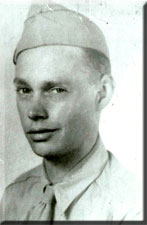
Ernest Leroy Barnes' Story ...
Private First Class Ernest Leroy Barnes was born in Mechanicstown, Ohio on June 6, 1921 ... Of course at that time no one knew that 23 years later on that same day, the most important operation of WWII would be carried out by the Allies in WWII ... Operation Overlord, codename for D-Day ... An operation which in the end would contribute to Ernest's premature death in the snowy hills of Belgium.
 Railroad just south of Mechanicstown, Ohio
Railroad just south of Mechanicstown, OhioErnest was the eldest son of Mrs. Cleo Barnes and Mr. John D. Barnes. There were 10 children in the family. Ernest had five brothers, Robert, Richard, Price, Donald, Delbert and four sisters: Ruth, Margaret, Winona and Wilda. All of Ernest's brothers served in the armed forces, his brother Delbert Barnes was in the Army, but for only two years and got out under medical conditions. The Barnes family was living in Carrollton, Ohio where Ernest attended grammar school.
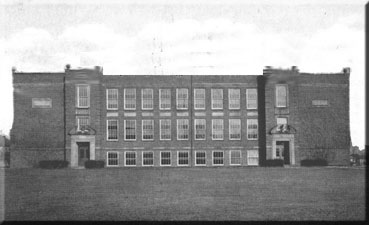
Carrollton High School, Carrollton Ohio.
In Ernest's early teens the Barnes family moved to Pekin, Ohio and Oneida, Ohio. In those difficult times Ernest dropped out of school at the age of only 14 years. Ernest had to help to support the family as many children were doing in those days of the depression.
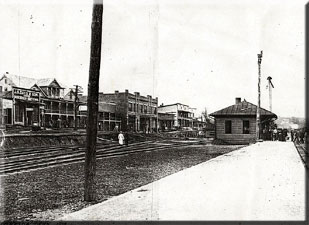 Souther Railway Station, Oneida, Ohio (1918)
Souther Railway Station, Oneida, Ohio (1918)After dropping out of school Ernest looked for a job and eventually he was employed as a Laundry laborer for the Pennsylvania Railroad. Ernest worked there until in December 1942 he entered the US Army.
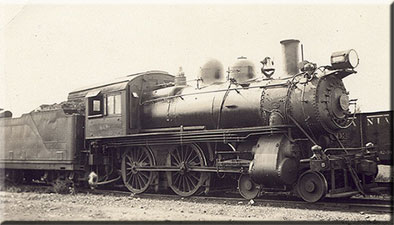 Steam Locomotive of the Pennsylvania Railroad
Steam Locomotive of the Pennsylvania RailroadErnest entered the US Army on December 9th, 1942 at the Army Induction Center, Akron Ohio. He went to the Army Processing Center at Fort Hayes on December 12, 1942. From there on he was transferred to Camp Van Dorn, Mississippi where his training continued. In August 1943 the 99th was beginning what was called "D" series maneuvers, they would last until September 9, 1943. This was just a warm up for the big maneuvers coming up September 17, 1943 in Louisiana ...
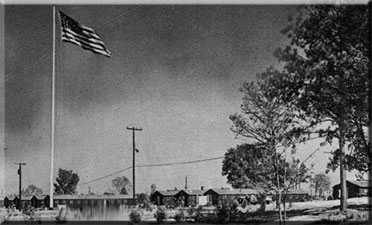 Camp Van Dorn, Mississippi
Camp Van Dorn, MississippiIn the months to follow Ernest's outfit walked hundreds of miles and crossed the Sabine River, which is the border between Louisiana and Texas. The Louisiana maneuvers finally ended on November 15, 1943. On 16 November 1943 his unit moved into Camp Maxey, Texas, according to Rev. John L Kuhn this was a welcome site after spending three months in the swamps. Several months before leaving for Europe the 394th Infantry Regiment was assigned a new company commander, Captain Wesley J Simmons. On his shoulder would rest the responsibility of leading the K Company 394th Infantry Regiment and he did successfuly.
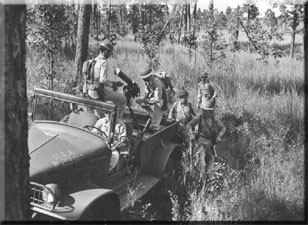 the Louisiana maneuvers in 1943 ...
the Louisiana maneuvers in 1943 ...September 12, 1944 ... the days of Ernest's outfit at Camp Maxey were over. They were transported to Camp Myles Standish, MA by troop train. The cars of the trains were equiped with folding bunks, a far cry from the old cars we travelled in on our original journey south. On September 15, 1944 we passed through Pittsfield, MA and we arrived at our destination, Camp Myles Standish, MA. It reminded one of Camp Van Dorn but they knew that their stay would be very brief.
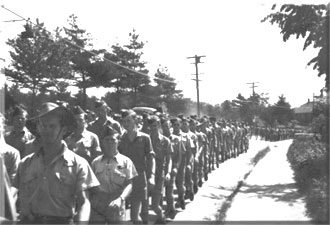 troops training just outside of Camp Myles Standish
troops training just outside of Camp Myles StandishOn September 29, 1944 Ernest and his comrades said goodbye to Camp Myles Standish. They climbed on trucks for the short ride into Boston, MA. This was their Port of Embarkation ... down to the docks and up the gang plank onto the troopship the S.S. Explorer, which was an old converted freighter, certainly not a luxury liner ! At that time of the year the north Atlantic can be rough and according to Rev. John L Kuhn on that voyage it certainly was. "During that voyage we did not lay and sleep. We took exercises and on one sunny, cold and windy day we went up on deck to take calisthenics. This turned out to be an exercise in futility, for the way the ship was being tossed by the waves, it was exercise enough just to try to stay on ones feet."
 Troopship Queen Mary - a converted luxury liner
Troopship Queen Mary - a converted luxury linerErnest and his comrades weren't so lucky with the SS Explorer ...
According to Rev. John L Kuhn things were getting a little
boring after being out at sea for more than a week ... "There was no contact with the outside world and nothing to look at
but the sky and the ocean. Then the Germans decided to give us some excitement. It was a bright and sunny afternoon when the
ships captain came in the ships inter-com, "Attention! All men on top deck to the port side and watch for torpedos ..."
It didn't take long to clear out the ship. We were all over the top of that ship. Any place we could climb we did.
Two
little Sub Chasers came in on our port and formed a "V". We had run into a Wolfpack. The destroyers started rolling over the
depth charges from the sides of their ships. As they exploded under water, the water shot higher in the air than the little
destroyers. After a few of these were dumped overboard we waited to see what would happen next. Then a large oil slick
appeared on the surface. The men gave out a cheer, one would have thought we were at a football game. At least one and
possibly more German subs would surface no more ..."
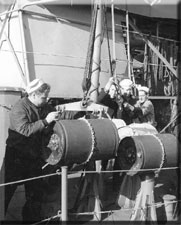
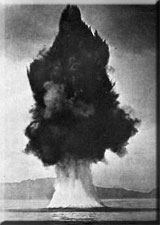
preparing a depth charge and the effect of the explosion ...
On October 11, 1944 Ernest and his unit sailed through the Irish Sea up the mouth of the river Clyde and dock at Guorock, Scotland. They were transported by troop trains and they arrived in Dorsetshire on October 13, 1944. On November 16, 1944 they landed at Le Havre, France.
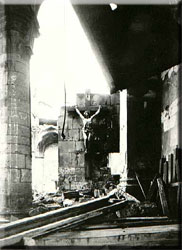 Le Havre, France ...
Le Havre, France ... detruction can take strange shapes ...
Having arrived in France the 394th Infantry Regiment was rushed across France into Belgium close to the German border in the Ardennes forest, "to a place that will live forever in our memories, Losheimergraben. It was on November 14, 1944 when we relieved the troops of the 9th Infantry Division. At first things were rather quiet. From November 14th to December 15th, in waist deep snow and dense woods, we patroled the Siegfried Line in our defense of Losheimergraben."
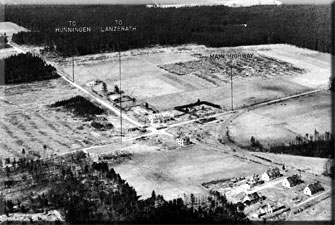 Losheimergraben in 1944
Losheimergraben in 1944Source US Army Center for Miltary History
Then it happened ... At 5.30AM on December 1944, Field Marshall Gerd von Rundstedt's forces struck. For almost two hours a saturating barrage of all calibers of mortar, artillery and Neberwerfer plastered the front. This was followed by six Germans Divisions, the 12th, 227th and the 326th Volksgrenadier, the 3rd Panzer and the 12th SS Panzer. German planes strafed and bombed the air, Fallschirmjäger landed to our rear, ski troops clad in white came through the rows of pine trees." The battle unfolding was to be called the Battle of the Bulge ...
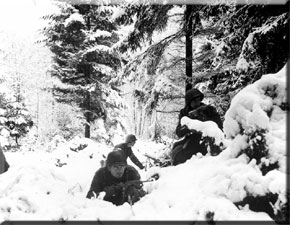
Fighting in waist deep snow in the Ardennes Forest
Ernest and his buddies gave everything they had and in many cases it was actually the last thing they had to give, the ultimate sacrifice, their life ... On the evening of December 17 1944 it was decided that they would retreat to new defensive positions, but in order to do that they had to break through the Germans to their rear. The new position would be Elsenborn ...
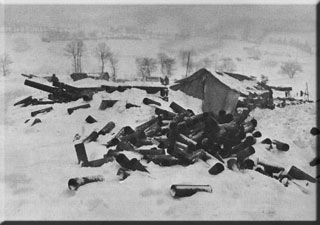 the Elsenborn Line on December 19, 1944
the Elsenborn Line on December 19, 1944The retreat to Elsenborn took until the evening of December 18, 1944. Sometime that day Ernest was wounded and while his comrades were depereately fighting their way back to Elsenborn Ernest was taken back to Stavelot to receive treatment ... He died a day later of his wounds on December 19, 1944. According to his report of burial Ernest sustained a penetration wound in the neck. Ernest was burried On December 19, 1944 at 14.00 hours in the temporary cemetery Henri-Chapelle in Plot OO, Row 8, Grave 152. That same day Ernest Pieck (153) and Ralph Digioia (151) were interred beside him ...
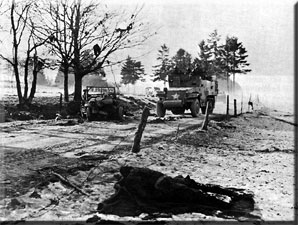 Death and Destruction along the American lines in the Bulge ...
Death and Destruction along the American lines in the Bulge ...These days Ernest rests in the beautiful American Military Cemetery at Henri-Chapelle ... He is remembered and honored by his entire family, by Richard Jones, by the people of the United States of America, by every visitor of the Henri-Chapelle cemetery and by everyone who visits the In-Honored-Glory website
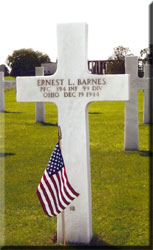 PFC Ernest L Barnes' final resting place
PFC Ernest L Barnes' final resting placein Henri-Chapelle American Military Cemetery (Belgium)
Special thanks Richard F Jones, Rev. John L Kuhn and to Ernest's family
published March 1, 2008